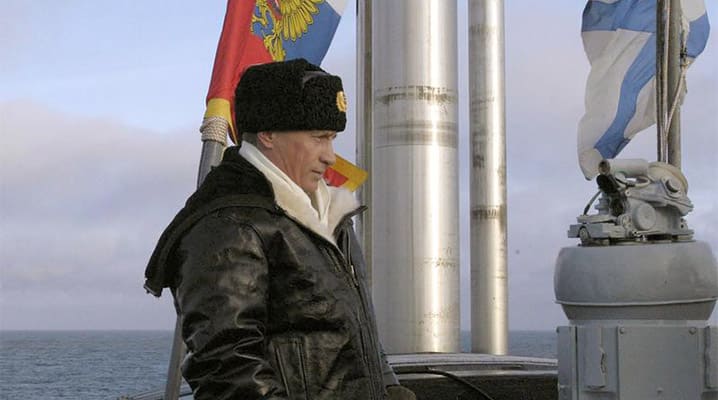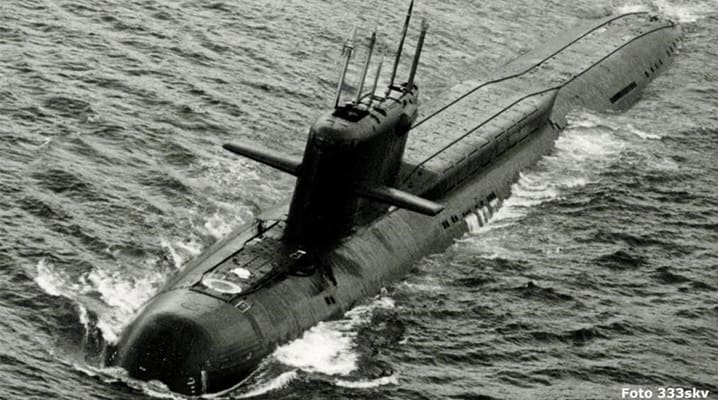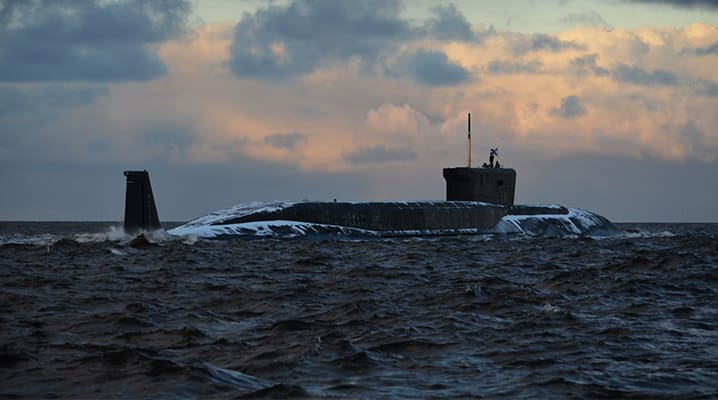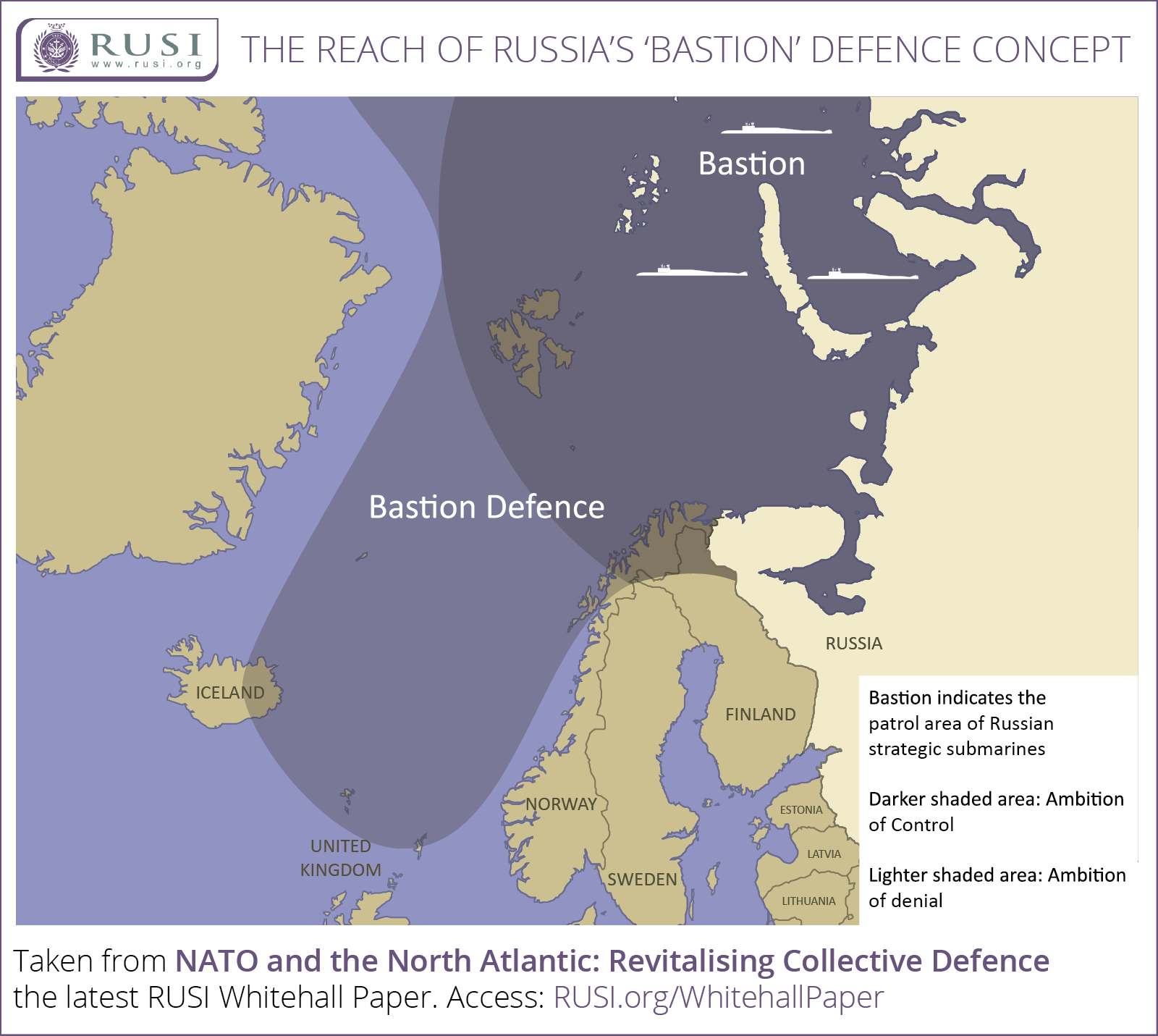Today we see the contours of a re-emerging debate and focus on Russia’s naval capabilities in the High North and the North Atlantic – not on the Arctic per se, which has been heavily debated for more than a decade, but rather on the global role of the Russian navy and its nuclear deterrent. Concerns about Russian strategic nuclear submarines (SSBNs) first came to the fore in NATO 50 years ago, with the advent of the Yankee class SSBN. This development received great attention in the 1967 annual intelligence reporting in NATO.

Russian President Vladimir Putin observes an exercise in the Barents Sea from aboard a submarine (February 2004). © REUTERS
The Soviet Union developed their Yankee and Delta classes of strategic submarines in response to the George Washington class of US submarines, which were equipped with Polaris missiles. The Yankee class is considered the first true Soviet SSBN, despite the earlier Hotel class. Combined with SS-N-6 missiles, the Yankee SSBNs, which became operational in 1967, had an approximate 2500 km range which allowed them to patrol at great distance from the US coasts in the mid-Atlantic.
A few years later, the arrival of the Delta SSBN equipped with SS-N-8 missiles gave the Soviet Union the potential even to launch attacks on the United States from home waters in the Barents Sea. The Northern Fleet came to define the Barents Sea (and later the Sea of Okhotsk) as closed areas for these SSBNs. These ‘Bastions’ became heavily defended by attack submarines, surface vessels and air power.
The strategic nuclear deterrent submarines and the Bastion Concept came to be recognised as the centrepiece of Russia’s second strike capability. However, it is worth remembering that Supreme Allied Commander Atlantic (SACLANT) failed in initial attempts in the 1960s to get the political leadership in NATO to focus on the emerging Soviet naval threat in the High North and North Atlantic and to expand the continental focus of the Supreme Allied Commander Europe (SACEUR).
SACLANTs concerns about the High North in the 1960s
The Scandinavian Peninsula was important throughout the Cold War. From its earliest years, the transit route of US nuclear-armed strategic bomber fleets passed over the northern parts of Scandinavia toward the central areas of the Soviet Union. In parallel, the Anglo-American carrier fleets operated in the Norwegian Sea for force projection, as well as for air protection for the strategic bombers. In addition, the United States supported a great build-up of Norwegian forces for the same purpose.
This US-led offensive use of the region lasted from the beginning of the Cold War until the early 1960s. By then, the nuclear-armed long-distance strategic missiles had emerged as the main Cold War weapon. The most northern areas became less important for the United States.
However, the strategic importance of the area had been perceived quite differently by the central organisation of NATO and SACEUR. The High North hardly featured at all in NATO strategy. NATO’s concern with the ‘northern flank’ had generally been associated with southern Scandinavia and the Baltic Sea and its approaches. The northern flank was given its headquarters in Oslo in 1951 and the northern command (Allied Forces North or AFNORTH) constituted the northern flank of SACEUR’s sphere of interest. But the prevailing perspective on the region was that of a ‘tactical northern flank’ to the Central Front.
In the early and mid-1960s, the Atlantic Policy Advisory Group argued there were three main rationales describing the strategic purpose of the northern flank (meaning Scandinavia):
- the barrier it presented to Soviet access to temperate waters;
- the bases it afforded for counter-offensive (including anti-submarine) operations; and
- its favourable location for the detection and warning of impending attack.
During the 1960s, SACLANT became increasingly aware of the Soviet naval build-up and sought – initially in vain – to get the NATO top level to focus more on the maritime issue. Two important studies produced by SACLANT in 1965 addressed the increasing Soviet naval threat – ‘Contingency Study for Northern Norway’ and ‘NATO Maritime Strategy’ – but had no immediate impact.

The Yankee I strategic submarine was developed by the Soviet Union in response to the George Washington class of US submarines, which were equipped with Polaris missiles. (displacement: 7,700 t (surfaced), 9,300 t (submerged)) Courtesy RNoAF 333 Squadron
Yet two years later, these studies came to prominence and were acted upon during discussions in 1967 on developing a new and more flexible NATO maritime strategy, based on two concepts, namely standing naval forces and maritime contingency forces.
NATO awakens to the SSBN threat
The strategic submarine build-up is generally accepted as very important for the strategies of the Cold War. However, a review of the NATO archives show that the early developments did not attract much attention within the central leadership of NATO (outside SACLANT). The strategic submarines had been around for a few years but the threat first featured prominently in NATO’s annual intelligence studies in 1967 (the SG/161 series of ‘The Soviet Bloc Strength and Capabilities’).
The existing strategic submarines were assessed to operate within two or three days steaming of launch areas off the United States. Many of these submarines were also capable of firing their missiles submerged (at least it was tested). However, in addition to the already operational submarines, a new ‘much improved’ SSBN class was expected to come into service by 1968. This correctly correlates to the NATO designated ‘Yankee class’, which by Soviet sources was reported operational by 1967.

The Borei-class Yuriy Dolgorukiy – the first Russian Navy strategic submarine to be developed after the end of the Cold War and the dissolution of the Soviet Union – started active deployments in 2014. (displacement: 14,720 t (surfaced), 24,000 t (submerged); 16-20 modern ballistic missiles, RSM-56 Bulava SLBMs, each with 6-10 MIRVed warheads) Courtesy DFI
Less noisy in the ocean than their predecessors and equipped with missiles of a longer range, the emergence of these submarines was a turning-point for the NATO leadership. It led to a shift in perception where the SSBNs were finally seen to be truly capable of strategic strikes and reckoned by NATO as a significant threat. This was the single most influential explanation why the High North, with the Soviet Northern Fleet, came to the centre of NATO strategy. The region was no longer viewed as just a subordinate theatre as the ‘tactical flank’ of the Central Front but evolved into an independent strategic theatre of operations.
In retrospect it is clear: the threat perceptions voiced over some years by SACLANT about the general and gradual Soviet naval and maritime build-up did not really get the attention of central leadership of NATO in Europe until 1967 – by which time the Soviet submarines had become a strategically important weapon.
Back to the future
The strategic nuclear deterrent submarines and the Bastion to protect this centrepiece of the second strike capability was well known to strategists during the last half of the Cold War – but it also remained important to Russia in the post-Cold War period. However, during the past two decades, academics, politicians and most militaries have been less focused on nuclear deterrence due to the demands of operational deployments beyond NATOs borders.
Today, as we see a return to great power politics, we must refocus our attention on the great power play of deterrence and address potential existential threats to our region, while of course not neglecting instability and asymmetric threats further afield.

Russian Borei-class strategic submarines are equipped with the SS-N-32 Bulava – an intercontinental-range, submarine-launched, solid propellant ballistic missile with a range of 8,300 km. © CSIS
We should in any case not have lost sight of the nuclear deterrent in dealing with the conflicts of the last twenty years. Nuclear deterrence has been and still lays the foundation for the Russian state to be able to (try to) act as a superpower. While Russia is no longer truly a superpower, from the nuclear deterrence perspective we still live in a MAD world, where three great powers are capable of Mutually Assured Destruction. Too little attention has been given to this fact, which sets the framework for the level of military and diplomatic force these nations can use and need to take into consideration when dealing with conflicts in Ukraine, the Middle East and elsewhere.
The Bastion concept and Russia’s nuclear deterrent is re-emerging as a topic of debate in academia. A transatlantic project report prepared by the Royal United Services Institute and Whitehall, in cooperation with the Washington-based Center for Strategic and International Studies is due to be presented at a seminar in NATO Headquarters in late March 2017.
Sources
This article is based on previous work by the author:
- ‘How the High North became Central in NATO Strategy: Revelations from the NATO Archives’, Journal of Strategic Studies, Aug 2011, Vol. 34 Issue 4;
- ‘The Northern Flank and High North Scenarios of the Cold War, in Bernd Lempke ed., Periphery or Contact Zone? The NATO Flanks 1961 to 2013 (Freiburg: Rombach Verlag, 2015).
For a review of the Bastion Concept today, see: Olsen, John Andreas ed., NATO and the North Atlantic: Revitalising Collective Defence, RUSI Publications, 6 March 2017.
For a recent seminar discussion on the topic, see: https://www.csis.org/events/nato-and-north-atlantic-revitalizing-collective-defense

